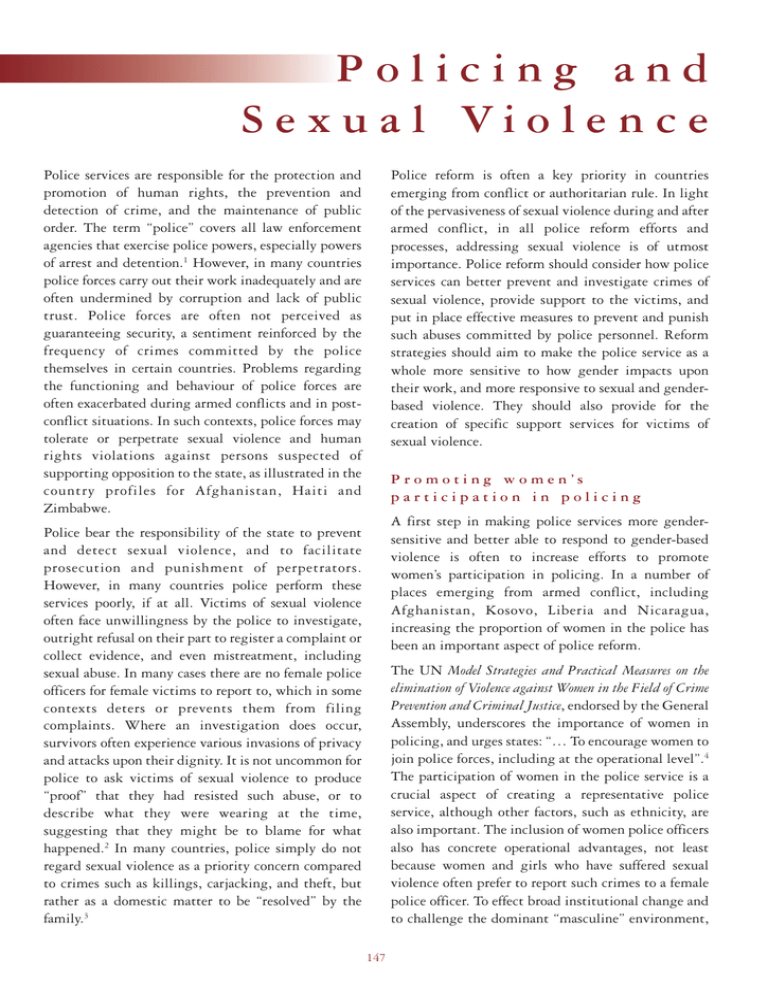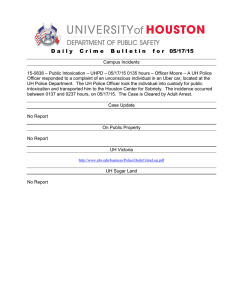
Policing and
S e x u a l Vi o l e n c e
Police services are responsible for the protection and
promotion of human rights, the prevention and
detection of crime, and the maintenance of public
order. The term “police” covers all law enforcement
agencies that exercise police powers, especially powers
of arrest and detention.1 However, in many countries
police forces carry out their work inadequately and are
often undermined by corruption and lack of public
trust. Police forces are often not perceived as
guaranteeing security, a sentiment reinforced by the
frequency of crimes committed by the police
themselves in certain countries. Problems regarding
the functioning and behaviour of police forces are
often exacerbated during armed conflicts and in postconflict situations. In such contexts, police forces may
tolerate or perpetrate sexual violence and human
rights violations against persons suspected of
supporting opposition to the state, as illustrated in the
country profiles for Afghanistan, Haiti and
Zimbabwe.
Police reform is often a key priority in countries
emerging from conflict or authoritarian rule. In light
of the pervasiveness of sexual violence during and after
armed conflict, in all police reform efforts and
processes, addressing sexual violence is of utmost
importance. Police reform should consider how police
services can better prevent and investigate crimes of
sexual violence, provide support to the victims, and
put in place effective measures to prevent and punish
such abuses committed by police personnel. Reform
strategies should aim to make the police service as a
whole more sensitive to how gender impacts upon
their work, and more responsive to sexual and genderbased violence. They should also provide for the
creation of specific support services for victims of
sexual violence.
Promoting women’s
participation in policing
A first step in making police services more gendersensitive and better able to respond to gender-based
violence is often to increase efforts to promote
women’s participation in policing. In a number of
places emerging from armed conflict, including
Afghanistan, Kosovo, Liberia and Nicaragua,
increasing the proportion of women in the police has
been an important aspect of police reform.
Police bear the responsibility of the state to prevent
and detect sexual violence, and to facilitate
prosecution and punishment of perpetrators.
However, in many countries police perform these
services poorly, if at all. Victims of sexual violence
often face unwillingness by the police to investigate,
outright refusal on their part to register a complaint or
collect evidence, and even mistreatment, including
sexual abuse. In many cases there are no female police
officers for female victims to report to, which in some
contexts deters or prevents them from filing
complaints. Where an investigation does occur,
survivors often experience various invasions of privacy
and attacks upon their dignity. It is not uncommon for
police to ask victims of sexual violence to produce
“proof” that they had resisted such abuse, or to
describe what they were wearing at the time,
suggesting that they might be to blame for what
happened.2 In many countries, police simply do not
regard sexual violence as a priority concern compared
to crimes such as killings, carjacking, and theft, but
rather as a domestic matter to be “resolved” by the
family.3
The UN Model Strategies and Practical Measures on the
elimination of Violence against Women in the Field of Crime
Prevention and Criminal Justice, endorsed by the General
Assembly, underscores the importance of women in
policing, and urges states: “… To encourage women to
join police forces, including at the operational level”.4
The participation of women in the police service is a
crucial aspect of creating a representative police
service, although other factors, such as ethnicity, are
also important. The inclusion of women police officers
also has concrete operational advantages, not least
because women and girls who have suffered sexual
violence often prefer to report such crimes to a female
police officer. To effect broad institutional change and
to challenge the dominant “masculine” environment,
147
there needs to be a “critical mass” of women officers in
any police service.
Gender training
Gender training is widely used to initiate and support
both behavioural and organisational change. Such
training can take myriad forms. However, it usually
includes briefings to clarify key gender terms (such as
the difference between sex and gender) and to identify
and challenge gender stereotypes. This involves
challenging pre-conceived notions that, for example,
women are more peaceable and will automatically use
less force than men, and exploring links between
models of masculinity and violent behaviour. Gender
training is a forum to discuss the different ways in
which men and women experience security, and to
build the capacity of the participants to respond
appropriately to the particular security needs of men,
women, boys and girls. The Beijing Platform for Action,
adopted at the Fourth World Conference on Women
in 1995, commits states to the development and
improvement of gender training for security sector
actors with a focus on gender-based violence.8
To increase women's participation in police services, it
is necessary to address not only recruitment policy, but
also issues related to the retention and advancement of
women. Gender-sensitive recruitment strategies
might include public campaigns targeting women;
reform of recruitment criteria to ensure that they do
not discriminate against women; and specific prerecruitment training to help women meet
employment requirements. Establishing employment
quotas for women in the police is one potential way of
increasing women’s participation. In Liberia, for
example, the Government, in collaboration with the
United Nations Mission, has developed a three-month
intensive Educational Support Programme for women
between the ages of 18 and 35 interested in joining the
Liberian National Police. The Programme aims to
ensure that the reformed and restructured Liberian
National Police has at least 20 per cent female
representation. A barrier to achieving this has been
that many Liberian women lack the basic educational
requirements for recruitment.5 To retain women in the
police, reform needs to be more far-reaching. It should
address sexual harassment and gender discrimination
in police institutions; arrangements allowing police
officers to combine job and family (such as flexible
working hours and day care facilities), and the
transformation of working conditions for both men
and women to ensure equal opportunities.
Gender training for police officers may be pre-service
training in police academies and/or in-service training
for active duty police personnel. Ideally there should
be a combination of both, involving all levels of police
officers.9 Gender training aims to create respectful,
gender-aware and non-violent behaviour within the
police sector, towards colleagues, and outside the
police sector, towards civilians. This is a precondition
to preventing sexual violence within the police service
and against members of the community.
Women's civil society organisations may bring
specific expertise to gender training and their
involvement in police training can help to build trust
between the community and the police. Women’s
groups have been involved in training the police on
gender issues in a number of conflict-affected
countries, including, for example, Bosnia and
Herzegovina, Cambodia, Nepal, and Nicaragua.10
Such groups can also play a useful role in civilian
oversight mechanisms, which help to ensure
accountability and transparency of police services, and
their adherence to human rights.
Greater participation of women in police services does
not necessarily lead to such transformations. Women
are not “by their nature” more gender-aware, nor will
women always push for gender reforms. Women
entering a predominantly “masculine” environment
rather tend to react accordingly by adopting
“masculine” behaviour. There are examples of female
officers being tougher on rape victims than male
colleagues in order to prove themselves.6 Women may
also feel marginalised by the dominant “masculine”
culture and therefore not “dare” to bring up gender
issues.7 The process of making police services more
gender sensitive, and thus better able to meet the
needs of women and girls, as well as boys and men, is
increased if promoting women’s participation is
combined with training to make all police officers
more gender-sensitive.
Karnataka State Police in India and UNICEF
developed a Training and Resource Manual for Police
Personnel with a focus on violence against women and
children as part of a “Gender Sensitisation and Peoplefriendly Police Project”.11 In 2003, the in-service
training process began and, in 2005, the project was
expanded to cover police training schools and
academies. By December 2006, over 2,800 police
148
personnel had been trained in workshops, and all
police stations in Bangalore city had at least one
person trained to handle cases relating to violence
against women and children.12
Police should have specialised operating procedures to
respond to complaints of sexual violence, and to ensure
that such complaints are investigated in a manner that
protects the rights of victims. The South African
Department of Justice, for example, worked with the
Police Service, the Departments of Health, Welfare
and Correctional Services, representatives from
different parts of the justice system and NGOs to
develop “National Policy Guidelines for Victims of
Sexual Offences”. These provide the Police Service
with detailed, step-by-step guidelines on supporting
victims of sexual offences, from how to receive a
victim, conduct interviews, collect statements, and
manage identification parades, to supporting the
victim in court and providing aftercare.15
Whilst gender training spurs institutional change,
police services also need to design and enforce
mechanisms to prevent and address acts of genderbased violence and discrimination by their personnel,
and to institutionalise specific responses to genderbased violence in the community. This should include
the introduction of codes of conduct regulating
professional behaviour, policies regarding sexual
harassment, and protocols and procedures to respond
to complaints of sexual and gender-based violence.
Measures and mechanisms to specifically address
sexual violence are discussed in the following section.
Another strategy to improve the way in which victims
of gender-based violence are handled by police has
been to establish specific police units designed to deal
with sexual and gender-based violence against women
and children. Sierra Leone, for example, in 2001
established Family Support Units. These entities
provide free legal aid to victims of domestic violence
(thus not sexual violence perpetrated outside the
family), organise community outreach campaigns to
inform the population about the implications of sexual
and gender-based violence and raise awareness about
the need to press charges against perpetrators. Trained
social workers are stationed in each Unit to ensure that
women and children are not re-victimised in the
interviewing process.16 The Family Support Units
have been hailed as a relatively successful attempt to
address sexual and gender-based violence. The model
is being replicated in Liberia, which has established a
Women and Children's Protection Unit within its
police. Its officers complete a specialised training
course in the handling and management of cases of
sexual and other forms of gender-based violence.17 In
Afghanistan, the UNFPA is supporting the
establishment of Family Response Units in the
Afghan National Police. These Units are staffed by
Afghan policewomen, who receive training to enable
them to react to violence against women, family
violence, children in trouble, and kidnappings, and to
provide support to female victims of crime; and
interrogate, detain and investigate female suspects.18
Improving police services to
victims of sexual violence
As set out in the Beijing Platform for Action, states have
the duty to “create or strengthen institutional
mechanisms so that women and girls can report acts of
violence against them in a safe and confidential
environment, free from the fear of penalties or
retaliation, and file charges.”13 The Beijing Platform for
Action commits states to a number of measures to
create such an environment. The UN Model Strategies
and Practical Measures on the elimination of Violence
against Women in the Field of Crime Prevention and
Criminal Justice similarly urges States:
(a) To ensure that the applicable
provisions of laws, codes and procedures
related to violence against women are
consistently enforced in such a way that
all criminal acts of violence against
women are recognized and responded to
accordingly by the criminal justice
system;
(b) To develop investigative techniques
that do not degrade women subjected to
violence and that minimize intrusion into
their lives, while maintaining standards
for the collection of the best evidence;
(c) To ensure that police procedures…
take into account the need for the safety of
the victim and others related through
family, socially or otherwise, and that
these procedures also prevent further acts
of violence.14
A variation of this model is “Women’s Police Stations”.
Staffed mainly by female police officers, Women’s
Police Stations have a particular mission to respond to
crimes of sexual and gender-based violence in a gendersensitive manner. They offer improved reporting
149
adult women, whilst others also attend to children and
adolescents. In some countries, such as Ecuador and
Sierra Leone, Women’s Police Stations exclusively deal
with domestic violence. In others, such as Argentina,
Brazil and Nicaragua, Women’s Police Stations also
handle complaints of violence committed by people
other than spouses.20 Nicaragua's experience of
Women’s Police Stations and gender reforms is
examined in Box 1.
facilities; support to the victims in matters such as
medical care, counselling and financial help; and help
victims to initiative legal action. Women’s Police
Stations have been established in, for example,
Argentina, Bolivia, Brazil, East Timor, India, Kosovo,
Nicaragua, Peru, Philippines, Sierra Leone, Uganda
and Uruguay.19 In some instances they were initiated
by women’s movements, in others by the national
police service, and at other times through the initiative
of United Nations peacekeepers or civilian police (as for
example in Sierra Leone, Kosovo and East Timor).
Women’s Police Stations vary as to their target
population, the forms of violence they deal with, the
services they provide, the way they are funded, the
actors involved (state and non-state) and the
distribution of responsibility between the different
actors. Some Women’s Police Stations only attend to
Conclusions
From Kosovo, to Sierra Leone and Liberia, Afghanistan
to Nicaragua, states emerging from conflict are striving
to improve the manner in which their police services
respond to gender-based violence. For some countries,
this includes for the first time taking meaningful steps
Box 1: Reform of the Nicaraguan police
Nicaragua's police service has been described as the
most “women-friendly” in the region, and is hailed
for its successful initiatives to address sexual
violence.21 The Nicaraguan police service was created
in 1979, after the Sandinista Revolution, with
women being integrated into the service from the
start. An estimated 35 per cent of police were women
in the 1980s (seen as partly a result of the strong
participation of women in guerrilla forces during the
preceding armed conflict). Women's participation
decreased during the late 1980s and 1990s. This was
attributed to neglect of the special needs of women
police, and in particular a decision to recruit only
those whom had completed training in the Police
Academy, even though this institute did not have the
necessary facilities to receive women.22
Policies were implemented to promote gender
equality and gender balance within the Nicaraguan
police, to transform gender values and attitudes
among police officers, and to develop institutional
mechanisms to respond to issues of gender and
violence within the police. For example, specific
policies to allow police officers to combine job and
family life were implemented, specific training for
women was provided, and height and physical
exercise requirements were adapted for women. The
Consejo Consultivo de Género was created as a forum for
discussion and investigation into the working
conditions of women police officers.24
Gender reforms of the Nicaraguan police sector were
initiated in the 1990s, following pressure from the
Nicaraguan women’s movement and from women
within the police. Support in the form of technical
cooperation and funding was provided by a number
of external institutions, including the German
Gesellschaft für Technische Zusammenarbeit and the
Swedish International Development Agency. 23
Reforms combined the two sets of strategies
mentioned above: making the police service more
gender-sensitive and more responsive to crimes of
Women’s Police Stations, called Comisarías de la
Mujer y la Niñez (CMNs), were first created in
Nicaragua in 1993, and later incorporated into the
formal police structure, and institutionalised at
national level. As of 2005, there were 23 CMNs in
Nicaragua, covering 68 per cent of the national
territory.25 CMNs offer services to individual victims,
and also to the broader community, in the form of
awareness-raising and prevention campaigns. They
adopt an inter-institutional and multi-disciplinary
approach, offering victims a wide range of services
150
sexual and gender-based violence, while also
providing specific services to women victims of
sexual and gender-based violence.
to welcome women into the police force. The
importance of training cannot be underemphasised: to
support women's entry into police services; to ensure
that police services and institutions are gendersensitive; and to provide services that meet the
particular needs of victims of sexual violence, whether
through integrated mechanisms or dedicated units,
such as Women’s Police Stations and Family Support
Units.
supporting victims of sexual violence, police services
must work with and alongside health and
psychological services, agencies responsible for shelter,
family welfare and socio-economic support, and those
that provide legal assistance. Cooperation must be not
only inter-departmental, but with civil society
organisations. Still, for many victims of sexual
violence, reporting the crime to a police officer is the
first, necessary step in seeking protection, assistance
and, ultimately, justice. For this reason, improving
security sector responses to sexual violence, in conflict
and after conflict, begins with building trained,
competent and committed police services.
In the state's response to sexual violence, policing
cannot be isolated from the rest of the criminal justice
process, including legislation, prosecution services,
courts, prisons, and compensation bodies. In
© Keystone, Bilderberg, Georg Knoll, 2004
free of charge, including legal advice and
representation, medical treatment and
forensic services, psychological counselling
and social support, with different services
provided by different state institutions and
civil society organisations.26
The CMNs provide a gender-friendly environment
where women and children can report violence
perpetrated against them in a climate of respect and
without fear of being re-victimised. An evaluation of
CMNs and their services in 2000, based on 1,948
interviews, showed that the majority of women
police officers were respectful and attentive to the
public, that they dealt well with people and were
well prepared to resolve problems.27
Despite being hailed as an example of good practice,
a number of concerns have been raised around the
operation of the CMNs. Firstly, it is argued that the
establishment of CMNs risks further marginalising
sexual violence and victim support services by
removing the issues from the centre of policing.28
Secondly, it has been said that training for officers in
CMNs assumed that women are “by nature” good
listeners and handle victims of sexual and genderbased violence better than men, and was as a result
inadequate.29 Thirdly, it has been claimed that the
inter-institutional character of CMNs can result in
competition and tension between the different actors
involved, undermining the provision of services.30
Speaking more broadly about Women’s Police
Stations in Latin America, Jubb has argued that “they
are not sufficiently linked to the judiciary, to ensure
that all the women who bravely decide to press
charges then see their cases go to trial”.31 Whilst these
are issues to be addressed in replication of the CMN
model elsewhere, Jubb has noted that institutional
strengthening of the CMNs has recently progressed,
signalling an increased commitment of the police to
CMNs.32 While obstacles remain in Nicaragua's
police reform process, Nicaraguan police have had
relative success in addressing sexual and gender-based
violence. This success seems to be attributable to the
comprehensive approach to both making the police
more gender-sensitive, and providing concrete
services for women victims of sexual and gender-based
violence. In addition, bringing together different
stakeholders, including women's civil society groups,
has helped to address sexual and gender-based
violence in a more integrated manner.
151
14
Endnotes
United Nations General Assembly, A/RES/52/86, Annex §8.
Department of Justice and Constitutional Development, South
African Police Service (1998) National Policy Guidelines for
Victims of Sexual Offences:
http://www.doj.gov.za/2004dojsite/policy/guide_sexoff/sexguide01.html.
16
Barnes, K., International Alert, Communication with the
authors, 9 March 2007; Campaign for Good Governance
(2004) Silent Victims, Young Girls at Risk: An Evaluation of PostWar Rape and the Response to Rape in the Provinces of Sierra Leone,
35-37.
17
UNICEF “New Women and Children Protection Section for
Liberia’s Police”, Press Release, 1 September 2005:
http://www.unicef.org/media/media_28159.html.
18
UNFPA (24 January 2006) Afghanistan’s First Family Response
Unit Open for Business:
http://www.unfpa.org/news/news.cfm?ID=740.
19
Swedish International Development Cooperation Agency
(1998) Conflict, Peace-building, Disarmament, Security: The Police
and Equality between Women and Men; Clegg, I. et al. (November
2000), 158.
20
Jubb, N. and Pasinato Izumino, W. “Women and Policing in
Latin America: A Revised Background Paper”, Latin American
Studies Association Meeting, Dallas, 27-29 March 2003, 5.
21
Jubb, N. and Pasinato Izumino, W. (27-29 March 2003), 21.
22
Deutsche Gesellschaft für Technische Zusammenarbeit GTZ
(2005), 26, 29, 232-33.
23
Jubb, N. “Gender, Funding, and the Social Order:
Contradictions among the State, the Women’s Movement, and
Donors regarding the Nicaraguan Women’s and Children’s
Police Stations”, Congress of the Canadian Political Science
Association, Toronto, 1-3 June 2006, 7-8.
24
Deutsche Gesellschaft für Technische Zusammenarbeit GTZ
(2005), 35, 47-49.
25
Deutsche Gesellschaft für Technische Zusammenarbeit GTZ
(2005), 49, 73-74.
26
Jubb, N. (1-3 June 2006), 2, 9, 13.
27
Deutsche Gesellschaft für Technische Zusammenarbeit GTZ
(2005), 76.
28
Clegg, I. et al. (November 2000), 27.
29
Jubb, N. and Pasinato Izumino, W. (27-29 March 2003), 17.
30
Jubb, N. (1-3 June 2006), 30-32.
31
Jubb, N., Communication with the authors, 21 May 2007.
32
Jubb, N. (1-3 June 2006), 25.
15
1
Organisation for Economic Co-operation and Security (2007)
OECD DAC Handbook on Security System Reform: Supporting
Security and Justice, Draft Edition, OECD, 163.
2
Jubb, N. “Enforcing Gendered Meanings and Social Order:
The Participation of the National Police in the Nicaraguan
Women’s and Children’s Police Stations”, Latin American
Studies Association Meeting, Washington DC, 6-8 September
2001, 2; Human Rights Watch (July 2003) Climate of Fear:
Sexual Violence and Abduction of Women and Girls in Baghdad, 1.
3
See for example Human Rights Watch (July 2003), 11.
4
United Nations General Assembly, Crime Prevention and
Criminal Justice Measures to Eliminate Violence against Women,
A/RES/52/86, 2 February 1998, Annex §8.
5
UNMIL “Liberia’s Education Minister Optimistic on the
Female Educational Programme for the Liberian Police”, Press
Release 53, 9 May 2007:
http://www.unmil.org/article.asp?id=2199.
6
Clegg, I., Hunt, R. and Whetton, J. (November 2000) Policy
Guidance on Support to Policing in Developing Countries, Centre for
Development Studies, University of Wales, 27.
7
Mangold, A. “The Peaceable Police Woman? – The Practice of
De-escalation in the Eyes of Female and Male Police Officers”,
Gender and Power in the New Europe, 5th European Feminist Research
Conference, Sweden, 20-24 August 2003, 11; Deutsche
Gesellschaft für Technische Zusammenarbeit GTZ (2005) Una
Historia que Merece Ser Contada: Modernización Institucional con
Equidad de Genero en la Policía Nacional de Nicaragua, 19962005, Managua.
8
United Nations, Report of the Fourth World Conference on Women,
Platform for Action, A/CONF.177/20, 15 September 1995, §
124(g) and (n).
9
Morrison, A., Ellsberg, M. and Bott, S. (October 2004)
“Addressing Gender-Based Violence in the Latin American
and Caribbean Region: A Critical Review of Interventions”,
World Bank Policy Research Paper 3438, 23.
10
UNIFEM (2001) Women, War, Peace: The Independent Experts’
Assessment on the Impact of Armed Conflict on Women and Women’s
Role in Peace-Building, 118.
11
Karnataka State Police and UNICEF (2003) Training and
Resource Manual for Police Personnel.
12
Jayasri, A. “Gender Sensitisation becomes a Part of Police
Training”, The Hindu, 2 May 2007:
http://www.hinduonnet.com/thehindu/thscrip/print.pl?file=2
007050204300400.htm&date=2007/05/02/&prd=th&.
13
United Nations, A/CONF.177/20, §124(l), (g) and (n).
152



